Experimental Research Regarding the Effect of Mineral Aggregates on the Wear of Mixing Blades of Concrete Mixers (2)
3. Results
3.1. Experimental Method
The results of the three sets of tests, corresponding to the blade tilt angles of 30, 45, and 60 degrees, for each of the three materials analyzed, are shown in Table 4, Table 5 and Table 6 and Figure 10, Figure 11 and Figure 12.
The selective aspect of the samples after different testing periods can be seen in Figure 13.
Table 4. Mass loss values determined during the experimental test for blades inclined at 30 degrees.
| Duration of Operation, (min) | Sample Mass during Experiment; Mass Loss; Δm; Respectively, ΣΔm; (g) | |||||
|---|---|---|---|---|---|---|
| Blade 1 | Blade 2 | Blade 3 | ||||
| 0 | 55.5200 | 0 | 54.7568 | 0 | 70.4701 | 0 |
| 60 | (Figure 13a) 55.4684 | 0.0516 | 54.7399 | 0.0169 | 70.4297 | 0.0404 |
| 0.0516 | 0.0169 | 0.0404 | ||||
| 120 | (Figure 13b) 55.4392 | 0.0808 | 54.7246 | 0.0322 | 70.3876 | 0.0825 |
| 0.0292 | 0.0153 | 0.0421 | ||||
| 180 | 55.4177 | 0.1023 | 54.7040 | 0.0528 | 70.3435 | 0.1266 |
| 0.0215 | 0.0206 | 0.0441 | ||||
| 240 | 55.3970 | 0.123 | 54.6790 | 0.0778 | 70.2913 | 0.1788 |
| 0.0207 | 0.0250 | (Figure 13d) 0.0522 | ||||
| 300 | 55.3731 | 0.1469 | (Figure 13c) 54.6527 | 0.1041 | 70.2330 | 0.2371 |
| 0.0239 | 0.0263 | 0.0583 | ||||
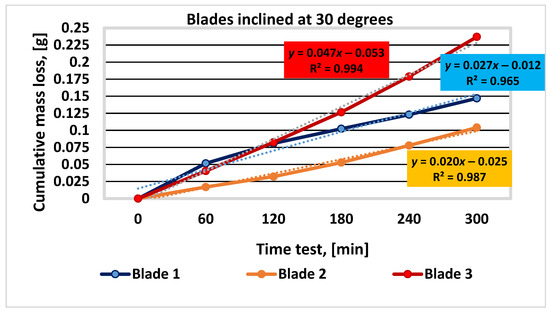
Figure 10. Graphical representation of the experimental results for blades inclined at 30 degrees.
Table 5. Mass loss values determined during the experimental test for blades inclined at 45 degrees.
| Duration of Operation, (min) | Sample Mass during Experiment; Mass Loss; Δm; Respectively, ΣΔm; (g) | |||||
|---|---|---|---|---|---|---|
| Blade 1 | Blade 2 | Blade 3 | ||||
| 0 | 55.3731 | 0 | 53.3737 | 0 | 69.7735 | 0 |
| 60 | 55.3408 | 0.0323 | 53.3507 | 0.0230 | 69.7360 | 0.0375 |
| 0.0323 | 0.0230 | 0.0375 | ||||
| 120 | 55.3098 | 0.0633 | 53.3313 | 0.0424 | 69.7051 | 0.0684 |
| 0.0310 | 0.0194 | 0.0309 | ||||
| 180 | 55.2814 | 0.0917 | 53.3100 | 0.0637 | 69.6683 | 0.1052 |
| 0.0284 | 0.0213 | 0.0368 | ||||
| 240 | 55.2556 | 0.1175 | 53.2967 | 0.077 | 69.6299 | 0.1436 |
| 0.0258 | 0.0133 | 0.0384 | ||||
| 300 | 55.2282 | 0.1449 | 53.2768 | 0.0969 | 69.5849 | 0.1886 |
| 0.0274 | 0.0199 | 0.0450 | ||||
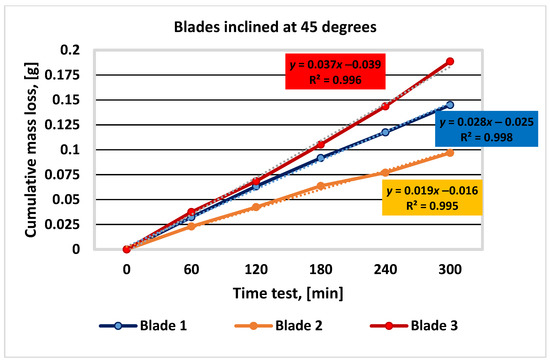
Figure 11. Graphical representation of the experimental results for blades inclined at 45 degrees.
Table 6. Test results on the experimental stand for blades inclined at 60 degrees.
| Duration of Operation, (min) | Sample Mass during Experiment; Mass Loss; Δm; Respectively, ΣΔm; (g) | |||||
|---|---|---|---|---|---|---|
| Blade 1 | Blade 2 | Blade 3 | ||||
| 0 | 54.3974 | 0 | 54.6199 | 0 | 70.2322 | 0 |
| 60 | 54.3709 | 0.0265 | 54.6093 | 0.0106 | 70.1795 | 0.0186 |
| 0.0265 | 0.0106 | (Figure 13f) 0.0527 * 0.0186 | ||||
| 120 | 54.3467 | 0.0507 | 54.5925 | 0.0274 | 70.1387 | 0.0594 |
| 0.0242 | 0.0168 | 0.0408 | ||||
| 180 | 54.3263 | 0.0711 | 54.5794 | 0.0405 | 70.1055 | 0.0926 |
| 0.0204 | 0.0131 | 0.0332 | ||||
| 240 | 54.3135 | 0.0839 | 54.5642 | 0.0557 | 70.0672 | 0.1309 |
| 0.0128 | 0.0152 | 0.0383 | ||||
| 300 | (Figure 13e) 54.2958 | 0.1016 | 54.5531 | 0.0668 | 70.0324 | 0.1657 |
| 0.0177 | 0.0111 | (Figure 13g) 0.0348 | ||||
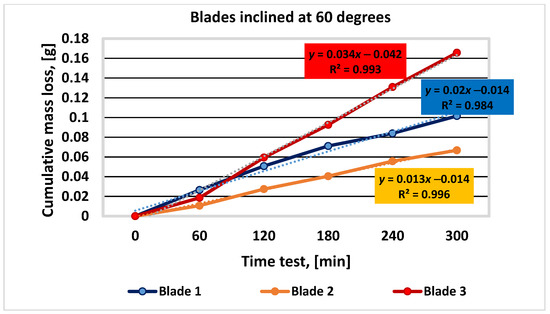
Figure 12. Graphical representation of the experimental results for blades inclined at 60 degrees.

Figure 13. The selective aspects of the samples after different test periods (noting that when operating duration is increased, the traces of abrasive–erosive wear become more pronounced): (a) sample blade 1, after 60 min test, inclination 30 degrees; (b) sample blade 1, after 120 min test, inclination 30 degrees; (c) sample blade 2, after 300 min test, inclination 30 degrees; (d) sample blade 3, after 240 min test, inclination 30 degrees; (e) sample blade 1, after 300 min test, inclination 60 degrees; (f) sample blade 3, after 60 min test, inclination 60 degrees (noting sample chipped due to entrapment of an aggregate grain between the blade and the drum); and (g) sample blade 3, after 300 min test, inclination 60 degrees.
3.2. Theoretical Method
A series of simulation results are presented in Figure 14, Figure 15 and Figure 16 regarding the variation of the ratio between the frictional force (manifested on the surface of the mixing blade) and the weight of the aggregate material that loads the blade (𝐹𝑓/𝐺) during operation, depending on the angle θ. For the angle of inclination α of the active face of the blade, relative to the shaft axis, three cases were considered: α=30∘, α=45∘ and α=60∘. For the sliding frictional coefficient μ between the aggregate material and the blade, the following cases were considered: μ = 0.25, μ = 0.3, and μ = 0.35. The simulations were performed for θ∈[0,π/3].
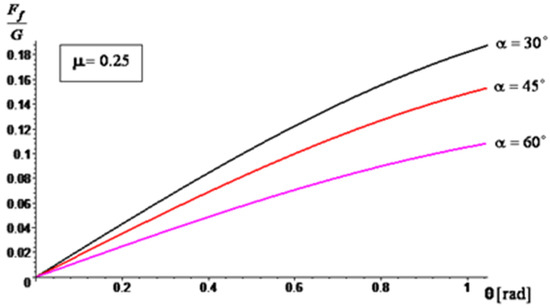
Figure 14. The ratio variation, 𝐹𝑓/𝐺 for μ=0.25.
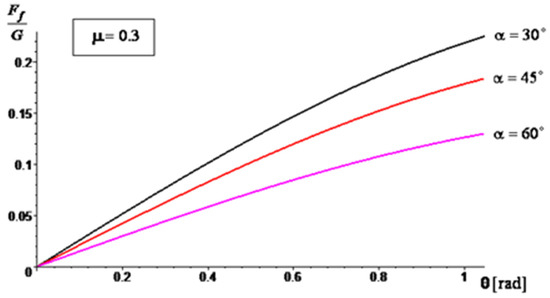
Figure 15. The ratio variation, 𝐹𝑓/𝐺 for μ=0.30.
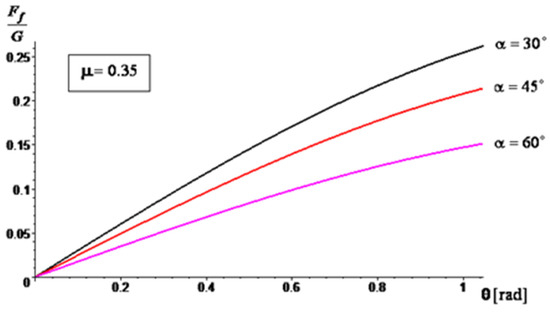
Figure 16. The ratio variation, 𝐹𝑓/𝐺 for μ=0.35.
4. Discussion
After analyzing the results presented in Table 4, Table 5 and Table 6 and Figure 9, Figure 10 and Figure 11, it can be concluded that blade no. 2 (with 26% Cr) has the smallest mass loss (smaller with 50%, … % and 90%, … 127% compared to blade no. 1 (4% Cr) and blade no. 3 (9% Cr), respectively) and therefore the best wear resistance for all the values of inclination angle of the blade. These conclusions are similar to those from scientific paper [1], where the authors investigated the wear behavior of the same materials but using a different experimental method.
Blade no. 1 has a better wear behavior than blade no. 3. The differences between the cumulative mass loss between blades no. 1 and no. 3 are 61.4% (for the inclination angle of 30 degrees), 30.16% (for the inclination angle of 45 degrees), and 63.09% (for the inclination angle of 60 degrees).
On the other hand, when the inclination angle of the blade relative to the shaft axis increases, the cumulative mass loss decreases, with the maximum values of 44.58% for blade no. 1, 55.83% for blade no. 2, and 43% for blade no. 3.
Numerous striations/rhizomes (resulting from the abrasive-–erosive action of the aggregates) were observed on the sample surfaces (Figure 13).
The results of the simulations show that by increasing the angle α, the ratio 𝐹𝑓/𝐺 decreases. This decrease is more accentuated when the sliding frictional coefficient between the aggregate material and the blade increases. Therefore, as the angle of inclination increases, the frictional force experienced by the blade decreases in relation to the weight of the aggregate material being carried by the blade. This suggests that a higher angle of inclination can potentially reduce the load and frictional forces on the blade during operation, which may have implications for the performance and wear characteristics of the mixer. The analytical method through the obtained results confirms the experimental results, so the testing method proposed by the authors can be used to also assess the wear behavior of other similar industrial equipment.
5. Conclusions
This paper presents the results of tests on corrosive–abrasive wear obtained with an experimental stand designed and built by the authors with reference to a real concrete mixer. The stand was capable of reproducing in-laboratory conditions, the phenomena that occur during the operation of real concrete mixers, related to the loadings of an abrasive–erosive nature to which the mixing blades are subjected.
Through the proposed experimental program, the authors wanted to verify the conformity of the obtained results using this method (in approximately similar conditions as industry) with the results obtained through previous tests, where laboratory instruments specific to the tribological tests of materials were used (the Baroid-type tribometer).
In order to justify the mechanical phenomena, the paper also presented an algorithm for calculating the frictional forces that develop when the aggregate particles move on the surface of the mixing blades during the mixer operation.
The main conclusions of the paper are as follows:
• The analytical calculation regarding the influence of the inclination angle and the sliding frictional coefficient between the aggregate material and the blade—on the ratio between the frictional force (manifested on the surface of the mixing blade) and the weight of the aggregate material that loads the blade during operation—suggests that modifying the inclination angle can have a significant impact on the frictional forces experienced by the mixing blade during mixing;
• When the angle of inclination is increased, the relative contribution of frictional forces to the overall load on the mixing blade decreases, indicating a potential reduction in wear and mechanical stresses on the mixer components. Moreover, the effect is more substantial when the sliding frictional coefficient between the aggregate material and the mixing blade is higher, emphasizing the importance of considering material properties and surface interactions in mixer design and operation. Overall, these results highlight the potential benefits of optimizing the angle of inclination in mixer blade design to minimize frictional forces and improve the longevity and performance of the mixer in handling aggregate materials with varying frictional characteristics;
• The experimental results (graphically represented in Figure 10, Figure 11 and Figure 12) confirm and are in full agreement with the observations reported in the paper, which presents a wear test method using the Baroid tribometer. According to these results, mixing blade no. 2 with 26% Cr exhibits the best wear resistance among the tested mixing blades, while mixing blade no. 1 (with 4% Cr) performs better than mixing blade no. 3 (with 9% Cr). These conclusions are consistent with the results mentioned in paper. In addition, the results specified in this paper demonstrate that this behavior of the materials is maintained under the conditions of different inclination angles of the mixing blades. This conclusion superimposed on the effect of inclination angle can provide important information for choosing the best technical solution for the concrete-mixer design;
• Regarding the chemical composition of the mixing-blade materials, it can be stated (in accordance with the assessments from [1]) that the chromium content plays a significant role in determining the wear behavior of the three types of cast iron;
• According to reference, cast irons with chromium percentages above 10% show increased wear resistance. The typical range of Cr content assumed in the formulas for such cast irons is 10–35%, being in accordance with the experimental results obtained for mixing blade no. 2;
• In industrial applications related to the production of cement concrete, it is advisable to use cast iron with either 25% Cr or 4% Cr. The choice of the intermediate grade (9% Cr) is not justified due to the higher cost and inferior performance compared to the 4% Cr version. Detailed explanations are given in;
• Additionally, the design and construction aspects demonstrating (in accordance with the experimental results) that increasing the angle of inclination of the mixing blades relative to the shaft axis leads to decreased cumulative mass loss and improved wear resistance for all mixing blades must be considered;
• As the angle of inclination of the mixing blades increases, erosive wear becomes predominant, accelerating the phenomenon of mechanical degradation of the samples. When choosing the right angle of inclination of the mixing blades, the mixing efficiency ensured by the position of the mixing blades must also be taken into account. In this way, by using the observations related to the materials used for the mixing blades, the angle of inclination of the mixing blades, and the efficiency of the mixing process, optimal solutions can be found for the design and manufacture of concrete mixers;
• The method proposed by the authors can be recommended for the study of wear phenomena in similar industrial equipment.




